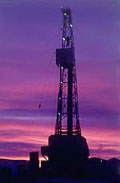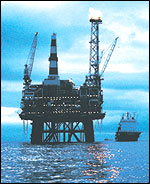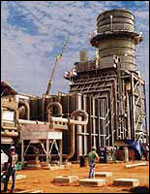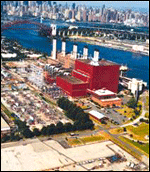It’s clear from the name alone that liquefied natural gas (LNG) is an oxymoronic commodity — but its chemical state is just one of the many paradoxes of this increasingly popular energy source. On the one hand, natural gas is the cleanest-burning fossil fuel and among the most viable near-term alternatives to coal, which currently accounts for more than 50 percent of the U.S. electricity supply. Many environmentalists have advocated it as an energy source that contributes minimally to climate change and air pollution when compared with the rest of the fossil-fuel family.

Well, well, well.
Photo: DOE.
On the other hand, enviros in the U.S. have fought long and hard to make ecologically sensitive, gas-rich territories (think coastlines and the Rocky Mountains) off-limits to drilling, and have waged war against certain methods of extracting natural gas, such as coal-bed methane mining, which has contaminated the water table and scarred the land in Wyoming’s Powder River Basin.
These two positions are difficult to reconcile: If environmentalists want to use natural gas instead of, say, coal and oil, the fuel must come from somewhere — and if the U.S. does not permit more drilling in its own territory, our gas imports from other countries will escalate, thereby exporting the environmental consequences to foreign nations, which may have more lenient environmental protections than we do.
This dilemma is suddenly quite pressing, for two reasons. First, our available domestic supply of natural gas has plateaued while our reliance on it increases. More than 90 percent of new electricity generators coming on line today — often to displace dirtier, less efficient plants — are powered by natural gas. So it’s clear that soon enough, even with aggressive energy-efficiency programs, we will either need to open up more protected lands to natural-gas development or begin importing the commodity from abroad.
Second, importing natural gas has just recently become a financially viable option. It used to be that natural gas was strictly a national or continental business, limited by its molecular form — gas — to distribution only by land-bound pipelines. Nearly a century ago, scientists discovered that natural gas could be chilled to the point of liquefaction so that it, like oil, could be shipped to a faraway point of use, but only in the past several years has the technology become inexpensive enough to make it a viable alternative to coal or piped natural gas.

Ships that gas in the
night.
Photo: DOE.
Not a moment too soon, argue energy analysts Daniel Yergin and Michael Stoppard in “The Next Prize,” an article in the November/December issue of Foreign Affairs. “There is a growing urgency to make investments in LNG in the near term in order to avoid more serious disruptions in gas markets and economies later in the decade,” they argue. That echoes a statement made this past July by famously understated Federal Reserve Chair Alan Greenspan, who said that dwindling domestic supplies of natural gas were “a very serious problem,” and went on to detail the threats that problem poses to the U.S. economy. Indeed, in the United States, natural gas prices have doubled since the second half of the 1990s — something that anyone who pays gas-heating bills knows all too well. In the last five years, natural gas production in the U.S. has flattened, indicating that our recoverable domestic supplies have peaked (just as our domestic oil supplies did 30 years ago).
For more than half a century, the United States has been largely self-sufficient when it comes to natural gas, except for imports from Mexico and Canada, which account for 15 percent of our supply. Yergin and Stoppard predict that from here on out, our dependence on foreign supplies will only escalate: “In the next five years, [the U.S.] is likely to become a large gas importer; within 10 years, it will overtake Japan as the world’s largest.”
In addition to being the author of the Pulitzer Prize-winning book The Prize: The Epic Quest for Oil, Money and Power, which chronicles the meteoric growth of the oil industry over the last century, Yergin is chair of the energy consulting firm Cambridge Energy Research Associates, which advises traditional energy companies. (Stoppard is a principal in the firm.) As such, Yergin opens himself up to criticism that his analysis reflects an industry bias, prioritizing growth over, say, conservation and energy efficiency.
Fair enough, but the development of natural gas is one of the few areas where industry and environmental concerns inevitably overlap, no matter how much emphasis we place on energy efficiency. Groups ranging from the Natural Resources Defense Council to Greenpeace have advocated natural gas as the fossil fuel best-suited to carry us through the transition into a hydrogen economy.
“We support the development of new [combined-cycle and co-generation] natural-gas power plants because they are far cleaner than coal,” said Ralph Cavanagh, a senior attorney at NRDC and commissioner with the National Commission on Energy Policy. “And in order to displace coal plants, we need reliable, affordable sources of natural gas.” Inevitably, said Cavanagh, we have to address the question of where and how we get the fuel. If we want to continue protecting sensitive areas such as the Rocky Mountains and coastal regions that have large untapped gas resources but are off-limits to developers, “then we have to seriously consider the importance of importing LNG from abroad.”
The Gas Is Always Greener …
Natural gas is by far the cleanest of fossil fuels; generating electricity from it emits a mere 40 percent of the carbon dioxide produced by generating juice from coal. Another environmental advantage natural gas has over fossil fuels is the combined-cycle gas turbine (CCGT), a new technology for natural-gas power plants borrowed from jet-engine design that is nearly twice as efficient as traditional plants, boasting 70 percent efficiency compared to the 30 to 40 percent efficiency of plants that burn oil and coal. CCGT plants are also easier to finance, quicker to build, and can be located close to cities because they are so much smaller and cleaner than traditional power plants.

A combined-cycle
natural gas turbine
station.
Photo: DOE.
“Natural gas is the most viable option in non-attainment areas such as the Northeastern and Northwestern regions of the United States, which have no choice but to add the most efficient and least polluting generation available in order to comply with clean air regulations,” said David Manning, senior vice president of corporate affairs at KeySpan energy company, the largest distributor of natural gas in the Northeast. (Non-attainment areas are those that don’t meet the standards of the federal Clean Air Act.)
Still, the same environmentalists who support natural gas over coal also argue, along with E. Kyle Datta, managing director of research and consulting at the nonprofit Rocky Mountain Institute, that in general, it is more cost-effective and far better for the environment to decrease demand through efficiency than to increase supply. “The easiest and best thing to do about the gas shortage is save peak electricity,” said Datta, citing a recent study demonstrating that we can easily reduce electricity demand by 15 percent for under 5 cents per kilowatt-hour by 2005. “Efficiency would more than replace all the LNG projects being contemplated, at lower cost, with a far greater payback,” said Datta.
Without a doubt, such a plan should be priority No. 1. Environmentalists consistently argue that energy efficiency is the single most important response to the mounting energy crisis. And yet, even if it is possible to use efficiency to more than offset the projected increase in demand for natural gas of roughly 2 percent per year, the fact remains that more than 50 percent of the U.S. energy supply is generated by outdated, heavily polluting coal plants (which are now exempt from making certain upgrades to their pollution-control technology, following the Bush administration’s recent rollback of the Clean Air Act’s New Source Review rules).
“We need to keep our eye on the principal villain, which is the aging fleet of dirty coal plants,” said Cavanagh. “And we need to come up with a displacement plan to get those plants off line. In the past, high natural gas prices made many utility systems reluctant to bring in more natural gas to displace coal, which, at least as an interim measure, most environmentalists favor. LNG allows for more certain and lower natural gas prices, which is vitally important to make our displacement plan economically viable.”
In other words: Natural gas is the only near-term, cost-competitive alternative to filthy coal production capable of providing cleaner, reliable base-load supply (i.e., supply that can run 24 hours a day, as opposed to renewables, which only generate electricity when the sun shines or the wind blows).
“In the end, of course, the question is: How quickly can we get away from all fossils and go to renewables?” said Ashok Gupta, senior energy director at NRDC. “But that will be a long, arduous process, and in the meantime we need to focus on transition technologies. We need to focus on dramatically improving energy efficiency as well as increasing natural gas capacity, while moving as quickly as possible to renewables and hydrogen.”
Indeed, even the beginning stage of the “hydrogen revolution” relies on natural gas. The cheapest and most common method of producing hydrogen is steam methane reformation, a process that involves extracting hydrogen atoms from natural gas molecules. Already, a Virginia-based company, H2Gen, has developed portable fueling stations that will hook up to existing natural gas lines and, using steam methane reformation, crank out hydrogen on location at a cost competitive with that of gasoline. The hope is that eventually solar and wind can be used to harvest hydrogen, but, in the meantime, H2Gen’s portable stations are an exciting development.
But hydrogen production, of course, accounts for a tiny fraction of the rise in natural gas demands; the lion’s share of that increase belongs to the electricity industry. “Altogether, the use of natural gas in electric power production has increased almost 40 percent since 1990, with much more growth to come,” wrote Yergin and Stoppard. A staggering 200,000 megawatts of new natural-gas power-plant capacity has been built in the U.S. recently and is just now coming on line. That’s a colossal quantity, equivalent to more than one-quarter of the country’s entire installed capacity in 2000, and greater than the entire electric power industries of the United Kingdom and France combined.
And that’s just the beginning. Natural gas demand is projected to increase by nearly 50 percent in the next two decades, and net imports are projected to increase by more than 200 percent, according to the Energy Information Administration, which develops official statistics for the U.S. Department of Energy. And the percentage of LNG in our total natural gas demand is expected to rise from less than 1 percent today to nearly 30 percent in 2025.
“The growth in LNG is viable largely because it is now cost-competitive with piped-in gasoline,” said Manning of KeySpan. “If natural gas were as cheap as it was in the ’90s — when it was roughly $2 per thousand cubic feet — LNG wouldn’t be an attractive alternative, but today it’s more than double that.”

I heard it through the
pipeline.
Photo: DOE.
Actually, recent improvements in engineering and construction brought LNG production costs down by as much as 30 percent. “Most of these reductions have occurred in the liquefaction part of the process,” said Stoppard, “which is the most energy-intensive part.” To import natural gas, it must be chilled to minus 260 degrees Fahrenheit, at which temperature it converts to a liquid and reduces in volume. Once liquefied, “an amount of [natural gas] that would normally fill a beach ball can fit inside a Ping-Pong ball,” according to a Time magazine article entitled “The U.S. Is Running Out of Energy,” from July 21, 2003. Once shipped to terminals in the U.S., the liquid is slowly warmed up until it returns to its gaseous state, then sent through pipelines.
This might seem like a preposterously energy-intensive process, but in fact, it’s surprisingly efficient. There’s no refrigeration required, because once the gas is liquefied, it just sits in giant insulated thermoses. As the liquid is shipped, it warms very slowly and some gas escapes from the containers, but the waste gas is captured and actually used to run the ship’s engine. The re-gasification process simply consists of warming the liquid to room temperature, and requires very little energy.
“Over the course of the LNG process, from extraction to point of use, a surprisingly negligible amount of the original harvested quantity is lost — less, in fact, than is lost piping gas thousands of miles from the upper reaches of Canada or from Mexico, as we do today,” said Cavanagh.
LNG also has a long-term pricing advantage over pipeline gas, in that it is based on 20- to 30-year contracts. Traditionally, natural gas prices have been highly volatile, mainly because they are susceptible to weather-driven swings. (Very cold winters or very hot summers cause dramatic spikes in demand for gas heat and electricity, respectively.) LNG facilities, which require investments of up to $5 billion in machinery and infrastructure, are built with long-term supply commitments; those commitments also help stabilize prices, which is good for consumers and for the economy.
Is the Gas Half-Full or Half-Empty?
As with everything, of course, LNG has its drawbacks. Chief among them is a very tricky siting process. The tankers that carry LNG are, on average, 1,000 feet long — not exactly the sort of thing you can easily park off of Manhattan, or any other major port city. Yet it is highly concentrated urban areas that need natural gas most. The solution, some say, is to park the tankers and processing facilities in more remote areas and feed the supply into the existing pipeline infrastructure, but even these hook-up locations are difficult to site.

Sketch of a CCGT plant
proposed for New York
City.
lllustration: New York Power Authority.
Concerned about such siting issues and anxious to spur domestic development, the Department of Interior has its eyes set on opening up more federally protected land in the United States to gas production. “There will be serious consequences if we don’t increase our natural gas supply, and LNG will be part of the solution,” said Bud Dannenberger, chief of the engineering and operations division at the DOI’s Minerals Management Service. But the better solution, he argues, is right under our nose. “We have substantial resources available in, for instance, the outer continental shelf of the United States, 85 percent of which is under moratorium. We need to open our eyes to the importance of opening up new areas to development. Why bring gas into a place when you can produce it right here?”
Environmentalists do need to take a hard look at the tradeoffs of exporting environmental damage versus keeping it within U.S. boundaries. The environmental impacts of drilling for natural gas off our own coasts are probably not any worse — and potentially better — than drilling for the resource in an exporting country, though the extent of the potential damage depends on the sensitivity of the region and the stringency of environmental protections. “Clearly, we need to develop diplomatic and international ways of dealing with this concern,” said NRDC’s Gupta. “We need to develop ways to ensure that the [drilling and extraction] practices both domestically and internationally are environmentally sound and consistent.”
Assuming that LNG imports do increase in the coming years, environmentalists need to cooperate in the effort to streamline siting processes, which have become far more elaborate in the last decade, with the result that “the length of time to get a license [for off-shore re-gasification facilities] has doubled or tripled,” said Yergin. “Environmental controversies over licensing and siting issues, which could disrupt investment, need to be managed sensibly, and regulations coherently applied.” In other words, as Greenspan told Congress, “We cannot, on the one hand, encourage the use of environmentally desirable natural gas in this country while being conflicted on larger imports of LNG.”
But even if those regulations were vastly simplified and LNG imports were accelerated, even if natural gas plants began to displace ever more coal plants and air quality continued to improve, there would still be an irrefutably ominous aspect of this new global gas business: national security. “What makes LNG perhaps least attractive is the risk of terrorism or accident,” said Amory Lovins, CEO of the Rocky Mountain Institute. “One thousand-foot LNG marine tanker being hit by a [missile] would be a megaton range firestorm. It’s not something you want anywhere near a city.”
So far, companies have sited re-gasification facilities at safe distances from major cities and funneled the gas into the pipeline supply. Furthermore, that same safety argument could be made of oil tankers, which arrive on our shores daily. To protect against such a crisis, we have developed safety technologies such as bullet-proof containers, and there’s no reason similar features couldn’t be used for LNG transport.
At least as worrisome as the threat of terrorism, then, is the fact that, 30 years ago, soon after the United States joined the world oil market, this country morphed quickly from being a minor petroleum importer to a major one. As Yergin and Stoppard noted in their article, that skyrocketing demand helped set the stage for the oil crises of the 1970s and created dangerous dependencies that, today more than ever, are plaguing not just our environment, but our economy and security. The increasing interest in LNG could result in a similar situation, with the U.S. radically increasing its dependence and incurring all the associated environmental and foreign-policy entanglements.
On this count, however, Yergin is optimistic. “I think we can learn from history’s example and preempt the kind of crises we’ve faced with oil dependency,” he said, and went on to explain that the regions that are rich in natural gas — Indonesia, the Algerian desert, the seas of Trinidad and Nigeria, eastern Russia, northern Norway, and the foothills of the Andes — are far more diverse and decentralized than the Middle Eastern region that controls more than two-thirds of the world’s entire oil supply. In sum, Yergin argues, maintaining a diverse portfolio of natural-gas resources can insulate us from the kind of national and economic security issues we face with oil.
Still, supporting an increase in natural gas production involves many tradeoffs — environmental and otherwise. Particularly notable are the damage to land and water sources inherent in natural gas extraction and production, the concern that such damage will only be exported to other countries even if we stave it off at home, and the security threat implicit in increasing dependence on foreign resources. The clearest and least controversial solution is an aggressive plan in energy efficiency, but that alone won’t eradicate our need for natural gas. As environmentalists grapple with these difficult tradeoffs, it’s important to remember Ralph Cavanagh’s advice: Keep your eye on the real villain.


